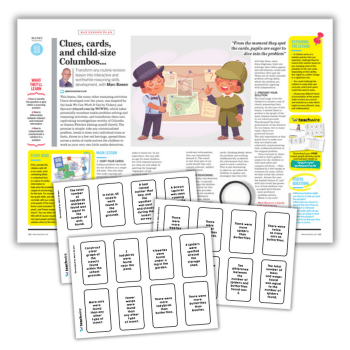Should Your Primary Pupils Take A Computational Or Strategic Approach To Maths Problem Solving?

Faced with a choice between computational and strategic methods, there᾿s a clear winner if we want children to understand the big ideas in maths, and not just get the right answer, says Mike Askew…

- by Mike Askew
- Educator, researcher and speaker with a focus on primary maths education Visit website

I invite you to consider these two calculations, and how you would work out the answer to each.
345 – 197 12 x 25
Setting aside ‘I’d reach for my smartphone’, there are different possibilities for each. One approach is to use the standard vertical algorithm:
345 25 – 197 x 12
That works, but is it the most efficient approach for these particular examples? For the subtraction, one might instead reason that subtracting 200 is easy, so we can do 345 – 200 and then adjust the answer (by adding on three to compensate for subtracting three more than 197). Or reading the subtraction as a difference can lead to reasoning that the difference between 345 and 197 will be the same as the difference between 348 and 200, and that’s 148. With the multiplication, since 25 is a quarter of 100 we can calculate that 12 x 25 is equivalent to 12 x 100 divided by 4. And finding that 300 is the answer to the latter is easily done if we᾿re confident that halving, then halving again, is the same as dividing by four. Or, as with the subtraction, we might choose to set up an equivalent calculation: 12 = 3 x 4, so 12 x 25 = (3 x 4) x 25 = 3 x (4 x 25) = 3 x 100 = 300. I distinguish between these two broadly different approaches by calling the first a computational approach – using a standard vertical algorithm irrespective of the numbers involved – and the second a strategic approach – selecting an approach dependent upon the numbers involved. So which is better – a computational or strategic approach? Advocates of the computational approach argue that it is more efficient in terms of thinking and decision-making – you only need one method for each of the four operations. That argument is based on the assumption that the main thing being taught is how to accurately calculate an answer. The argument for working with strategic approaches is that it engages the learner in more than simply finding the answer; bald calculations become an opportunity for problem solving and reasoning – problem solving because they have to think about the calculation, not carry out a routine procedure, and reasoning because strategic methods are based in some big mathematical ideas. In the case of the subtraction, the big idea is one of constant difference: that the difference between 345 – 197 is the same as the difference between (345 + 3) and (197 + 3), or (345 + 5) and (197 + 5) or, generally, 345 – 197 = (345 + a) – (345 + a) for any value of a. Expressing 12 x 25 as (3 x 4) x 25 and then recognising that that is equivalent to 3 x (4 x 25) is an embodiment of the associative rule: (a x b) x c = a x (b x c). Thus working on calculations strategically can provide the opportunity to talk about these big ideas and so bring together the National Curriculum aims of fluency, problems solving and reasoning.
Mini-lessons and reasoning chains
Reasoning mini-lessons are a way of working on and reasoning about calculations strategically and drawing out and discussing a big idea. They are mini-lessons in the sense of taking only between 10 and 15 minutes – sustaining this sort of work for a whole hour is not practical.
They are whole-class routines that support pupils in coming to grasp the underlying ideas through frequent exposure. A reasoning mini-lesson can take several forms: reasoning chains, true or false statements, open number sentences. Here, I’ll look at reasoning chains.
Reasoning chains are designed around three or four number sentences that have been chosen to build and connect in some way. In carrying them out, number sentence are put up on the board, one at a time, and learners are asked a question about each – sometimes this question will be simply about finding an answer; sometimes it will be about how to work something out; and sometimes it will be about whether or not children agree with something. A moment or two for pupils to think on their own about their answer (having a paper and pencil to hand can be helpful) is followed by ‘turn-and-talk’ – everyone turns to a neighbour and has a conversation about the question posed. During these moments of turn-and-talk, I find it helpful to move around and listen in to a few conversations and so decide who should be first to share their thoughts with the whole class. The whole class then discusses the question and agrees on the answer. If all that is being done is agreeing on an answer to a calculation, then I recommend simply scribing the different answers. For example, suppose the calculation was 12 x 8 and most learners say the answer is 96, but someone says 106. Write both suggestions on the board, adding others that may then emerge.
This then leads to another opportunity to turn-and-talk: “OK, we have two different answers. Turn and talk to a neighbour and see if you can agree on which is correct.” Learners offering an incorrect answer often see where they went wrong, and it’s better to have this time to go and talk quietly to these children to find out what their thinking was rather than to do this publicly. With the answer agreed, some visual image – and this is important – is provided to go alongside the calculation. This is repeated for the other sentences in the mini-lesson. Over the course of working through the three or four examples, the images build and make clear what big idea is emerging. When all is complete, the discussion can be about the underlying big idea. So what does this look like?
Bringing reasoning to the fore
The first calculation put up is:
6 x 10 =
This, I expect, would present pupils with little difficultly, and I would not spend a lot of time talking about at how the answer was arrived. The diagram drawn up alongside would be of a 6 by 10 array. (I’m assuming here that the pupils are familiar with arrays and that an open array showing the 6, 10 and 60 is sufficient – that they can picture the 60 individual squares that would be within.) The second calculation would then be put up.
6 x 30 =
This, again, should not be too challenging, but a short conversation about how this relates to 6 x 10 could be helpful. Again, an array is drawn up, in proportion to the 6 x10 array.
6 x 29 =
This is the calculation where the reasoning really begins to come to the fore. I’ve written before about the work of psychologist Ellen Langer demonstrating the power of ‘could’ – that looking at two different ways something could be done and thinking about the similarities and differences leads to deeper learning than only thinking about one way.
At this point in the chain, I’m therefore looking out for two different ways that pupils find the answer: by working out 6 x 20 and 6 x 9 separately and adding these two partial products, or by working from 6 x 30 and subtracting 6. If neither of these methods are forthcoming from the pupils, then I offer one myself. Now three things are recorded on the board:
1. The steps that the pupils talked through 2. The visual representations of these steps 3. A more formal mathematical set of equations showing the steps.
The final part of this mini-lesson would be discussing these two methods, and what is similar and what is different. The formal mathematical setting out of the steps reveals that behind each method is a big idea – the distributive rule. That is, 6 x 29 is equivalent to 6 x (20 + 9) = (6 x 20) + (6 x 9) and is also equivalent to 6 x (30 – 1) = (6 x 30) – (6 x 1). The lesson might then end, if there is time, with looking at a similar calculation, say 5 x 39.

The symbolic and the visual
As noted above, with each reasoning chain it is important to build up images alongside the symbols. It’s this embodiment of the underlying mathematical ideas through visual and diagrammatic representations that leads to deep understanding.
Symbols are not, in and of themselves, the mathematics. They only stand in for the underlying idea. It is the practical and visual that brings the ideas into being.
Symbols are like the speedometer in a car. The speedometer does not make a car go faster, it only reflects what is going on under the bonnet. Practical and visual images lift the bonnet on the mathematics and leads to mastery of the discipline.
Joined-up thinking
Try these reasoning chains with your class…
1. Addition 62 + 10
62 + 30
62 + 29
The big idea: the associative rule (62 + 29 = 62 + (20 + 9) = (60 + 20) + 9 or 62 + 29 = 62 + (30 – 1) = (60 + 30) – 1
2. Subtraction 62 – 10
62 – 30
62 – 29
The big idea: the associative rule (62 – 29 = 62 – (20 + 9) = (60 – 20) – 9 or 62 – 29 = 62 – (30 – 1) = (60 – 30) + 1
3. Multiplication 16 x 10
16 x 2
16 x 12
The big idea: the distributive rule (16 x 12 = 16 x (10 + 2) = (16 x 10) + (16 x 2)
12 x 8
6 x 16
3 x 32
The big idea: doubling and halving and the associative rule (12 x 8 = (6 x 2) x 8 = 6 x (2 x 8) = 6 x 16.
Mike Askew is adjunct professor of education at Monash University, Melbourne and a freelance primary maths consultant; for more information, visit www.mikeaskew.net or follow @mikeaskew26










